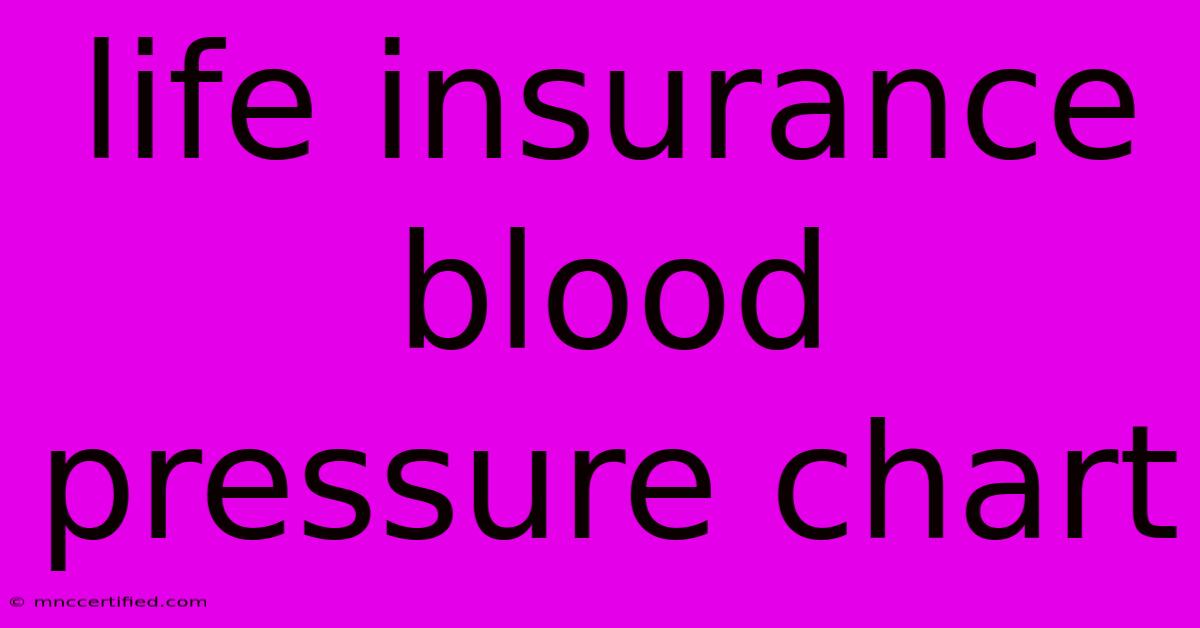Life Insurance Blood Pressure Chart

Table of Contents
Life Insurance Blood Pressure Chart: What You Need to Know
Life insurance is a crucial part of financial planning, ensuring your loved ones are protected in the event of your passing. However, your health plays a significant role in the life insurance process, and blood pressure is a key factor insurers consider. Understanding how blood pressure impacts your life insurance rates is essential, and this article will guide you through the complexities of life insurance blood pressure charts and how they affect your eligibility and premiums.
Understanding Blood Pressure and Life Insurance
Blood pressure is the force of blood pushing against the walls of your arteries as your heart pumps. It's measured in millimeters of mercury (mmHg) and consists of two numbers:
- Systolic pressure: The top number, indicating pressure when your heart beats.
- Diastolic pressure: The bottom number, indicating pressure when your heart rests between beats.
High blood pressure, also known as hypertension, is a significant health risk increasing your chances of heart disease, stroke, and other serious conditions. Consequently, life insurance companies view it as a potential risk factor, affecting your premiums and eligibility.
Life Insurance Blood Pressure Charts: How They Work
Life insurance companies use blood pressure charts as a tool to assess your health risk. These charts generally depict ideal blood pressure ranges categorized by age and other factors like gender and lifestyle. While specific charts may vary between insurers, the general principles remain consistent:
- Lower blood pressure generally signifies a lower risk, resulting in more favorable premiums.
- Higher blood pressure indicates a higher risk, potentially leading to higher premiums or even rejection of your application.
Impact of Blood Pressure on Life Insurance Premiums
Here's how blood pressure affects your life insurance premiums:
- Normal Blood Pressure: Individuals with normal blood pressure (typically below 120/80 mmHg) usually qualify for standard rates, enjoying the most competitive premiums.
- Elevated Blood Pressure: Those with slightly elevated blood pressure might be subject to increased premiums, typically a small surcharge.
- High Blood Pressure (Hypertension): Individuals with diagnosed hypertension might face significantly higher premiums or even denial of coverage depending on the severity and other health factors.
Tips for Getting Approved and Saving Money
If you have concerns about your blood pressure and life insurance, here are some tips:
- Get your blood pressure checked regularly: Maintaining healthy blood pressure is crucial.
- Control your blood pressure: If you have high blood pressure, follow your doctor's recommendations for lifestyle changes and medications.
- Be transparent with the insurer: Disclose your medical history honestly, including any blood pressure concerns.
- Shop around for quotes: Compare quotes from multiple insurers to find the best rates.
- Consider a term life insurance policy: These policies typically offer lower premiums and are less restrictive regarding health conditions.
Conclusion
Understanding the connection between blood pressure and life insurance is crucial for securing the best coverage. Maintaining healthy blood pressure not only benefits your overall health but also helps you qualify for more favorable life insurance rates. By following the tips outlined above, you can ensure you're making informed decisions about your life insurance needs and protecting your loved ones financially.

Thank you for visiting our website wich cover about Life Insurance Blood Pressure Chart. We hope the information provided has been useful to you. Feel free to contact us if you have any questions or need further assistance. See you next time and dont miss to bookmark.
Featured Posts
-
New Stop Smoking Pill Nhs Rollout
Nov 13, 2024
-
Prue Leith On Aging More Reckless
Nov 13, 2024
-
Black Panther 3 Denzel Washingtons Role
Nov 13, 2024
-
Insurance For Pest Control Business
Nov 13, 2024
-
Line Of Duty Star Speaks On Shows Future
Nov 13, 2024